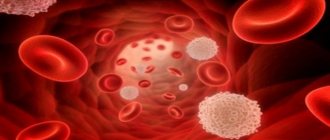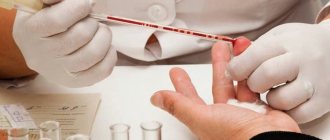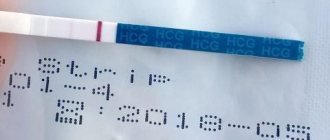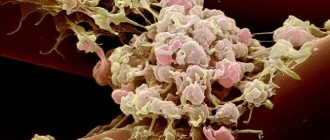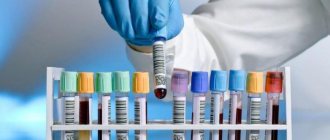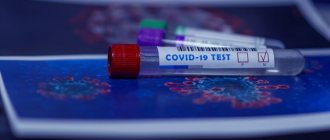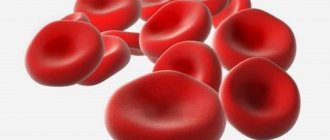A general blood test from a vein (clinical blood test) is one of the most common laboratory tests, which is carried out to monitor health status, clarify the diagnosis, select an algorithm and monitor the effectiveness of treatment.
Blood from a vein is taken for general analysis using a vacuum system
Before taking the test, it is advisable to consult with a doctor, which will allow you to obtain detailed information about what a general blood test from a vein is, what it can show and how to properly prepare for it. The interpretation of the analysis result should only be carried out by a qualified specialist.
Erythrocyte sedimentation rate (ESR) is one of the indicators determined during a general blood test from a vein. It is the ratio of protein fractions of blood plasma.
Preparation rules include avoiding physical and mental stress on the eve of the study. You cannot smoke on the day of the test. Blood for analysis is usually taken in the morning on an empty stomach. You are allowed to drink water before donating blood.
If you are taking medications, you should ask your doctor whether they can be used before taking blood or whether there is a need to stop them.
Collecting blood from a vein is usually done using a vacuum system or a closed system (monovet). Often, blood is taken from a finger for a general analysis.
Types of venous blood studies
Blood from a vein is suitable for various types of research. Each of them is prescribed depending on the clinical picture of the disease, medical history and other factors. It is worth understanding that blood tests are only one component of a comprehensive diagnostic scheme. Despite the fact that this fluid contains information about the condition of all organ systems, it is impossible to make a final diagnosis based only on these studies.
Types of tests that can be performed with venous blood:
- clinical (general) - based on counting blood cells, as well as identifying pathological components in the bloodstream, carried out by microscopy;
- biochemical - determination of the concentration of various biologically active substances, enzymes, lipids and other fractions that cannot be detected by simple microscopy (carried out on a special analyzer);
- immunological - necessary if various autoimmune diseases are suspected, as well as for differentiating potential allergens;
- hormonal - prescribed to monitor the functioning of organs that produce hormones; it is regularly performed for patients with diabetes mellitus, thyroid pathologies and other problems.
REFERENCE! Suitable for some tests, including blood from a finger. However, if the patient has to undergo several studies at the same time, it will be much easier to take it from a vein.
General information
Most people have been accustomed since childhood to the fact that blood is taken for analysis from a finger. But if the doctor needs to obtain the maximum amount of information and information about the structure of the blood, biomaterial is collected from the venous bed.
First of all, this is due to the fact that a larger amount of sample is required for a detailed analysis and detection of infections than for a clinical study. And also venous blood differs slightly in composition from capillary blood and contains a greater number of indicators, which is important for making an accurate diagnosis.
General analysis
A general (clinical) blood test is prescribed during routine preventive examinations. This is the simplest diagnostic method in which the liquid is examined under a microscope. Its purpose is to count the main blood cells, determine the concentration of normal and pathological forms, and notice foreign inclusions. Also, a general analysis can detect parasites. There are several main indicators that are determined during a general blood test.
The table shows the normal results of a general blood test for an adult:
| Index | Result |
| Hemoglobin (HGB) | In women - 120-140 g/l. In men - 130-160 g/l. |
| Red blood cells (RBC) | In women - 3.5-4.5*1012 g/l. In men - 4-5*1012 g/l. |
| Hematocrit (HCT) | For women - 37-46%. For men - 43-50%. |
| Platelets (PLT) | 180—320*109 g/l. |
| White blood cells (WBC) | 4-9*109 g/l. |
| Leukocyte formula | Neutrophils: band-nuclear (up to 6%), segmented (45-75%). Eosinophils - 0.5-5%. Basophils - no more than 1%. Lymphocytes - 20-40%. Monocytes - 3-10%. |
| ESR (ESR) | In women - 2-15 mm per hour. In men - 1-10 mm per hour. |
| Reticulocytes (RTC) | 0,5—2%. |
The leukocyte formula is calculated using a detailed blood test. It represents the percentage ratio between different types of white blood cells. Such a study is necessary if infection, inflammatory reactions, acute and chronic diseases of internal organs, as well as oncological processes are suspected.
Hemoglobin
Hemoglobin is a blood protein that contains iron. It transports oxygen and carbon dioxide, thereby ensuring gas exchange at the cellular level. Normally, this indicator increases with physical activity, as well as with a lack of oxygen in the inhaled air. It is also physiologically elevated in newborns. In other cases, its increase may indicate diseases or neoplasms in the kidneys and liver, or heart defects. Smoking and being overweight can also cause a similar picture.
A decrease in hemoglobin accompanies various types of anemia, including those caused by bleeding, and this indicator can also be reduced in pregnant women. Other causes of this picture are infectious processes, malignant neoplasms, thyroid diseases, and cirrhosis of the liver.
A full analysis can be done in the laboratory: for clinical and biochemical studies, blood is taken in one procedure
Red blood cells
Red blood cells are called erythrocytes. They contain hemoglobin and participate in gas exchange between cells. The number of these cells is normally increased in newborns, as well as under any factors that reduce the supply of oxygen to the body. Their concentration may increase with smoking or drinking alcohol, diseases of the cardiovascular system, heart defects, kidney disease and other specific cases.
A decrease in red blood cell levels is a dangerous condition. It can be observed in any type of anemia, kidney and thyroid diseases, and also accompany malignant processes. However, it is considered normal during pregnancy.
Hematocrit
Hematocrit is the ratio of red blood cells to the volume of the liquid part of the blood. An increase in this indicator may indicate erythremia (an increase in the volume of red blood cells), kidney and cardiovascular diseases, and Itsenko-Cushing syndrome. This picture is also observed in newborns and in old age, with prolonged smoking.
Blood tests may also show a decrease in hematocrit, that is, a decrease in red blood cells in relation to the liquid part of the blood. The cause of this condition is all the factors that cause a decrease in the volume of red blood cells.
Platelets
Platelets are small cells that do not contain nuclei. Their main function is the regulation of blood clotting, and they are especially important during bleeding. Their number can be increased in various tumor processes, infectious diseases and disorders of the hematopoietic organs. This process is also normally observed after injuries and operations. An increase in the volume of these cells is dangerous due to vein thrombosis.
A decrease in the number of platelets indicates a deficiency in the blood clotting mechanisms. This may be the result of sclerosis of the arterial walls, heart failure, diseases of the spleen, and various tumors. Normally, this picture is observed in women during menstruation.
REFERENCE! To decipher blood tests, it is important to correctly collect anamnesis data. Thus, the picture changes with the patient’s age, as well as depending on the physiological state, complexion and even air temperature.
Leukocytes
Leukocytes are white blood cells that make up the majority of cell mass volume and are divided into several categories. They undergo differentiation during their development and enter the bloodstream already mature. Each fraction is counted separately. An increase in all types of leukocytes occurs during infectious diseases, pathologies of the hematopoietic organs and thyroid gland, after operations and under heavy stress. Their decrease is the result of congenital diseases, exposure to heavy metals and other factors, including radiation.
You can also read: Blood indicators for blood diseases
- Neutrophils are large cells that participate in the processes of phagocytosis (absorption of bacteria). Their increase is associated with infectious diseases, stress, tumors, and may also indicate myocardial infarction. The decrease in these cells is caused by pathologies of the thyroid gland and is observed in anaphylactic shock.
- Eosinophils are another type of white blood cell. Their increase often indicates the presence of parasites, as well as during allergic reactions and exacerbation of autoimmune diseases.
- Basophils are found in the smallest quantities and are activated during inflammatory processes. Their increase is a consequence of infection or allergic reactions.
- Lymphocytes are one of the most important fractions necessary to create immunity. Their increase occurs during infectious processes, allergies and poisoning. A decrease in lymphocytes is more dangerous and may indicate immunodeficiencies, cancer, and autoimmune reactions.
- Monocytes are large cells that also participate in phagocytosis. They are actively produced during infectious processes, as well as during autoimmune diseases. Their decrease may be due to injuries, surgical interventions, as well as leukemia.
When counting leukocytes, not only their number matters, but also their condition. A small percentage of immature forms is acceptable, but their appearance in large numbers indicates a deficiency of the hematopoietic systems. This picture may indicate the development of leukemia.
ESR
Erythrocyte sedimentation rate is an indicator that allows you to determine the ratio between protein fractions in the blood. The test is carried out in a test tube and is based on the ability of red blood cells to settle to the bottom of the container. The rate increases with inflammatory reactions, kidney and liver diseases, various types of anemia and hormonal disorders.
Blood is most often taken from the central ulnar vein, but if this is not possible, it can be collected from the veins of the hands or lower extremities
Decoding the result
Only a qualified physician should carry out the analysis and decipher the information obtained during the study.
- increased concentration of red blood cells. Most often observed in congenital heart diseases, leukemia and chronic pulmonary pathologies. A reduced level may be a sign of anemia, prolonged fasting, leukemia or metastasis of malignant tumors;
- decrease in leukocytes. The analysis shows this result for bacterial and viral diseases, bone marrow pathologies, arthritis, anemia and renal failure;
- increase in leukocyte levels. Indicates viral, infectious and fungal infections. And also excessive concentration occurs with severe bleeding, chronic anemia, intoxication, extensive burns;
- an increase in platelet concentration indicates the following pathological conditions: rheumatoid arthritis, myelofibrosis, lymphoma, tuberculosis, ulcerative colitis, osteomyelitis;
- delayed erythrocyte sedimentation. Observed with prolonged use of corticosteroids and muscle fiber dystrophy;
- accelerated erythrocyte sedimentation may indicate kidney disease, acute inflammatory diseases, intoxication, and the formation of malignant tumors;
- low hemoglobin can occur after prolonged bleeding, anemia and can also be a sign of some hereditary diseases.
Biochemical analysis
A biochemical blood test from a vein is performed to assess the functioning of organs and systems. This fluid contains not only cells, but also chemicals that cannot be detected even under a microscope. For a general study, this data is not needed: for biochemistry, blood is taken only if pathologies of internal organs are suspected. To understand what types of tests there are, it is important to understand what is in its composition.
- Proteins (normally 60-85 g/l) - their total amount is determined. It can increase with dehydration, infectious or allergic diseases. A decrease in protein concentration is the result of tumor processes, acute and chronic pathologies of the gastrointestinal tract.
- Lipids (4.5-7 g/l) - the total amount can be increased in case of liver disease or diabetes. Cholesterol is determined separately: its normal level is 3-6 g/l. Its increase indicates atherosclerosis and can be observed during pregnancy. Decreased cholesterol is a sign of thyroid deficiency.
- Glucose is one of the most important indicators. The normal blood sugar level is 3.5-5.5 mmol/l. An increase in this indicator is dangerous and indicates pathologies such as diabetes mellitus and thyroid dysfunction. It is worth understanding that sugar levels are not constant and may increase after eating.
- Vitamins and inorganic compounds: chlorine, calcium, potassium, iron, sodium and others. These data are necessary only if there is a suspicion of hypo- or hypervitaminosis, deficiency or excess of minerals.
- Nitrogenous substances are an indicator of kidney function. Thus, urea (2.6-6.4 mmol/l) and creatinine (from 53 to 97 mmol/l for women, from 62 to 115 mmol/l for men) increase with renal failure and urinary outflow disorders, and may also indicate myocardial infarction.
- Bilirubin is a copper-containing pigment. The normal level of total bilirubin is 5-10 µmol/l; direct and indirect fractions can also be determined. Its increase indicates liver dysfunction, blood loss, poisoning and infectious diseases, which are accompanied by the destruction of red blood cells.
- Enzymes - by their activity one can judge the functioning of internal organs. Thus, aminotransferases increase with liver inflammation, muscle damage or myocardial infarction. No less acute conditions cause an increase in the activity of lactate dehydrogenase and creatine phosphokinase.
REFERENCE! A separate increase in one or more indicators, without a clear clinical picture of the disease, is not yet a reason for making a diagnosis. Examinations include ultrasound diagnostics and other methods.
How to donate blood correctly?
It is recommended to donate venous blood in the morning on an empty stomach. You should not eat food for 8 hours, and abstain from drinking alcohol and medications for several days. If there is a need to take medications on a regular basis, you must notify your doctor. On the eve of the analysis, you should not undergo active physical activity, it is advisable to ensure yourself peace. The timing of the analysis depends on the laboratory. If necessary, results can be ready within a few hours. In most cases, the patient can pick them up the next day, and the analysis is deciphered by the attending physician.
Taking venous blood is indicated for suspicion of many diseases, as well as during routine examinations. It is not recommended to take it without prior preparation - this may affect the test results.
Preparation process
Before a laboratory test, it is appropriate to consult a doctor to find out up-to-date information about what this procedure is and what such an analysis can show. Interpretation of the results is the responsibility of a person with appropriate qualifications.
How to prepare for the test:
- On the eve of the test, avoid mental stress and physical exertion.
- Do not suddenly change the daily routine to which you are already accustomed, and the composition of your diet: the body will be stressed.
- Most often, the procedure is carried out in the morning and on an empty stomach. Before taking blood, you can drink clean water and do not smoke.
- If you need to take any medications for medical reasons, ask your doctor in advance whether they can be taken before the procedure.
- In extreme heat, it is better to postpone this event.
Healthy people are recommended to undergo this test at least once a year.
Reference! If you take the test after 11 am, there is a possibility of getting an inaccurate result.

